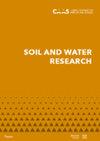Investigating rainfall duration effects on transport of chemicals from soil to surface runoff on a loess slope under artificial rainfall conditions
IF 1.7
4区 农林科学
Q4 SOIL SCIENCE
引用次数: 2
Abstract
The release and transport of soil chemicals in water erosion conditions are important for the local environment, soil and water resources conservation. According to the artificial rainfall experiments with a constant rainfall intensity of 90 mm/h and different rainfall duration (30, 60, 90, 120 and 150 min), the traits of soil PO43–, K+, and Br– release and transport from soil to surface runoff on the loess slope were analysed, and a model describing the chemical concentration change in surface runoff under soil erosion conditions was developed. The runoff coefficient quickly increased in 15 min or so, and then it was stable in the range of 0.60–0.85. The sediment intensity decreased in 30 min and soon increased after severe sheet erosion occurred on the slope. The concentration curve of Br– in surface runoff can be divided into two stages, quickly decreasing in the initial 30 min after the surface runoff occurred, and then stable. The concentration curve of PO43– and K+ in surface runoff can be divided into three stages, quickly decreasing like Br– was decreasing, then stable, and increasing after severe sheet erosion began. Compared with the exponential function, the power function was found more suitable for fitting the change in chemicals in runoff with unsaturated soil; while neither of them could well fit the PO43– and K+ concentration change after severe erosion occurred. The transport of chemicals under complex soil erosion conditions seems to be a dynamic release process between surface runoff and sediment. Based on the convection-dispersion mechanism and desorption kinetics, the polynomial model under soil erosion conditions was created. For adsorbed PO43– and K+, it is more suitable to simulate that process than the power function, while it is not so good for mobile Br–.研究人工降雨条件下,降雨持续时间对黄土坡地土壤化学物质向地表径流转移的影响
水蚀条件下土壤化学物质的释放和运移对当地环境和水土资源保持具有重要意义。通过恒定降雨强度为90 mm/h、不同降雨持续时间(30、60、90、120和150 min)的人工降雨试验,分析了黄土坡地土壤PO43 -、K+和Br -向地表径流的释放和输送特征,建立了土壤侵蚀条件下地表径流化学浓度变化模型。径流系数在15 min左右迅速增大,之后稳定在0.60 ~ 0.85范围内。坡面发生严重板蚀后,泥沙强度在30min内减小,而后又迅速增大。地表径流Br - in浓度曲线可分为两个阶段,在地表径流发生后的最初30 min内迅速下降,然后趋于稳定。地表径流中PO43 -和K+的浓度曲线可分为3个阶段,先随着Br -的下降而迅速下降,然后趋于稳定,在剧烈的板蚀开始后上升。与指数函数相比,幂函数更适合拟合非饱和土壤径流中化学物质的变化;但两者都不能很好地拟合剧烈侵蚀后PO43 -和K+浓度的变化。在复杂的土壤侵蚀条件下,化学物质的运移似乎是一个地表径流与泥沙之间的动态释放过程。基于对流-分散机理和解吸动力学,建立了土壤侵蚀条件下的多项式模型。对于吸附的PO43 -和K+,幂函数比幂函数更适合模拟这一过程,而对于移动的Br -则不太适合。
本文章由计算机程序翻译,如有差异,请以英文原文为准。
求助全文
约1分钟内获得全文
求助全文
来源期刊

Soil and Water Research
Water resources, Soil Science, Agriculture-WATER RESOURCES
CiteScore
4.60
自引率
0.00%
发文量
26
审稿时长
>12 weeks
期刊介绍:
An international peer-reviewed journal published under the auspices of the Czech Academy of Agricultural Sciences and financed by the Ministry of Agriculture of the Czech Republic. Published since 2006.
Thematic: original papers, short communications and critical reviews from all fields of science and engineering related to soil and water and their interactions in natural and man-modified landscapes, with a particular focus on agricultural land use. The fields encompassed include, but are not limited to, the basic and applied soil science, soil hydrology, irrigation and drainage of lands, hydrology, management and revitalisation of small water streams and small water reservoirs, including fishponds, soil erosion research and control, drought and flood control, wetland restoration and protection, surface and ground water protection in therms of their quantity and quality.
 求助内容:
求助内容: 应助结果提醒方式:
应助结果提醒方式:


